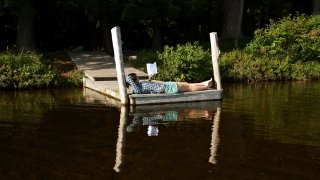
Message from the President
In the geography of small talk, the question, “what are you reading?” draws two sharply different reactions, twin banks of the same stream. It’s not meant to be disarming, but it apparently can be, perhaps like a cyclist catching soft crosswinds on a flat road. It takes a moment to adjust. For some, the passing interest in someone else’s reading may set a new boundary in polite conversation. To trespass that line, even unintentionally, risks stepping into a zone of personal privacy.
Of all places, colleges should vigorously insist that reading must go down, down deep through the page, and not just across it.
Not long ago, the question was as harmless as commenting on the overnight weather. Now, it may be a topic only for close friends to discuss or, at best, reserved for the trustworthy few who converge inside the Tuesday evening book club. Meanwhile, I still ask students and faculty all the time what they’re reading because talking about books, or whatever is being read for class or leisure, is still the essential work of a college, the work I’m supposed to encourage. My intuition of risking social blunder when asking about titles and authors, nevertheless, gives me pause to wonder what has changed.
Overall, what people are reading—novels, history, scientific literature, political opinion, how-to, and self-help—are consistently broad and representative. How people read, particularly students and my younger colleagues on campus, is noticeably different. It has become important to understand this question of how they read rather than what they read. Ultimately, because the underlying question can no longer answer itself, our society and our colleges must again ask why we must read, why reading is imperative in human essentials.
A woman of deep formative influence in my childhood came to the house once a week to tidy up and look after us when school was out. She had the moral authority of a third parent and was always addressed as Mrs. White—never called by her first name, especially never with the common Southern touch of adding “Miss” before the name. She traced all the years of my schooling and was nearby in the days I prepared to leave home for college. It was in that moment, she revealed to my mother that she had never learned to read.
Then in her late 60s, she had been taking a night class at her church in order to read sentences that I had mastered a decade sooner as a young boy. Emerson celebrated “creative reading” in “The American Scholar,” but, for me, heading into my first year, I was aware that Mrs. White must have already been a remarkably creative soul before she became a competent reader.

In her brave secret, I possessed a gift from her—I realized, humbly so, my great good privilege of education, and that no matter how deserving it seemed, it was arguably unmerited. My outlook on life expanded because I had personally witnessed “heroic reading.”
In college, reading as the vital means of learning, of being equipped, and of being intellectually fulfilled has never been more open and creative than the present. Course readings are now much more varied and brief in content than the massive text or a dozen paperbacks once were in the past. Alongside this assumption is the increasing concern today about the state of reading overall because it has almost become too easy to acquire, owing to altered forms of “seeing” information, sometimes with special effects, taking little courage and no heroic desire to gain acceptable literacy.
Our world is seriously challenged by not having an index yet for the emerging plurality of literacies. We are living in the moment of a peculiar phenomenon, one of shifting our eyes from page to screen. I believe we are experiencing something new in human history, so that a potentially damaging inverse proportion may one day be calculated—by comparing an older society committed to overcoming illiteracy to one that may be unlearning to read. Or, to be clear, the difference in our history and the future of reading is the loss of reading in-depth, having substituted superficial scanning for deeply understood comprehension and reflection.
The newer medium for reading adds convenience and immediacy, but the quality of focus and attention has undoubtedly suffered. It threatens “cognitive patience.” The media habits of people in their 20s are influencing all of us—on average, they will check their cell phones more than 150 times a day. They will switch media sources 27 times an hour. The human brain is not wired to think clearly or read deeply if there is a continuous diverting of attention, whether self-induced or manipulated by subliminal “persuasion design” features cleverly programmed into digital devices.
Maryanne Wolf, who studies the neuroscience of reading, summarizes the concern this way: “No self-respecting internal review board (IRB) at any university would allow a researcher to do what our culture has already done with no adjudication or previous evidence: introduce a complete, quasi-addictive set of attention-compelling devices without knowing the possible side effects and ramifications for the subjects (our kids).” She hopes, as do I, that eventually there will be common standards for achieving “parallel levels of fluency.” Stabilizing the dual existence of the print and digital word is likely St. Lawrence’s chief embodiment of purpose in the next generation.
The informational trend is irreversibly visual. Why, then, is traditional reading so important? Of all places, colleges should vigorously insist that reading must go down, down deep through the page, and not just across it. There is the well-known correlation between the quality of reading and the quality of thought, and by extension, our thought foretells the quality of our expression. Otherwise, how can we ever say what we mean? Ludwig Wittgenstein once revealed that the prelude to every philosopher’s work was the simple confession, “I have lost my way.” Google won’t help with that one. Reading with sharpened focus remains the most vivid, most convincing, most appealing activity to finding your way. —WLF




